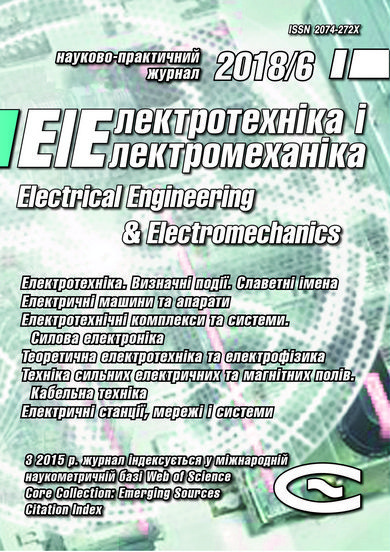EFFECT OF A DIELECTRIC BARRIER ON THE ELECTRIC FIELD DISTRIBUTION IN HIGH-VOLTAGE COMPOSITE INSULATION OF ELECTRIC MACHINES
DOI:
https://doi.org/10.20998/2074-272X.2018.6.09Keywords:
high-voltage composite insulation, dielectric barrier, fiberglass substrate, interfacial polarization, electric field distribution, long-term electrical strengthAbstract
Introduction. Modern high-voltage systems for composite insulation of electrical machines consist of tape glass mica paper materials (dry or pre-impregnated). The electrical characteristics of a multilayer composite insulation system are determined by both the fractional content of the individual components and their electrophysical properties. Purpose. The analysis of the influence of electrophysical characteristics and thickness (fraction) of the dielectric barrier on the distribution of the electric field in the composite high-voltage insulation of electrical machines. Methodology. Simulation of surface charge accumulation at the interface between the substrate and the dielectric barrier is based on the Maxwell–Wagner theory for interfacial polarization. Practical value. The influence of the electrophysical characteristics and thickness of the dielectric barrier on the distribution of the electric field has been established. In the steady state, the electric field strength in the dielectric barrier exceeds the average value by 50 %. In the region of small transition times (up to 1 s), the relative dielectric constant of the barrier has a significant effect on the distribution of the electric field. The use of a dielectric barrier with a higher dielectric constant and fractional content in comparison with the substrate leads to an increase in electric field strength by 5 % relative to the average value in composite insulation. Experimental studies of the long-term electrical strength of glass mica-belt ribbons in the cured (thermosetting) state are consistent with the simulation results. Composite insulation based on glass fiber mica tape with a high content of the mica barrier and fiberglass of smaller thickness has (8-16) % higher values of long-term electric strength.References
1. Ogonkov V.G., Serebryannikov S.V. Elektroizoliatsionnye materialy i sistemy izoliatsii dlia elektricheskikh mashin. V dvukh knigakh. Kn. 2 [Electrical insulation materials and insulation systems for electrical machines. In 2 books. Book 2].Moscow, Publishing house MEI, 2012. 304 p. (Rus).
2. Pak V.M., Trubachev S.G. Novye materialy i sistemy izoliatsii vysokovol'tnykh elektricheskikh mashin [New materials and systems for isolation of high-voltage electrical machines].Moscow, Energoatomizdat Publ., 2007. 416 p. (Rus).
3. Rebinder P.A. O vliianii izmenenii poverkhnostnoi energii na spainost', tverdost' i drugie svoistva kristallov [On the effect of changes in surface energy on the cleavage, hardness and other properties of crystals]. Congress of Russian physicists. The list of reports submitted to the congress, with a brief summary.Moscow -Leningrad, 1928. 29p. (Rus).
4. Gibbs J.V. Termodinamika. Statisticheskaia mekhanika [Thermodynamics. Statistical mechanics]. Moscow, Nauka Publ., 1982. 584 p. (Rus).
5. Mikhailov V.M. Initial relations and approximate boundary conditions for calculating the field in systems with thin layers. Electricity, 2007, no.3, pp. 49-55. (Rus).
6. Kim Yong Dar, Kalmykov V.L. Study of the electric field of an insulating structure with thin extended areas. Bulletin of NTU «KhPI», 2005, no.42, pp. 65-70. (Rus).
7. Bezprozvannych G.V., Boyko A.N. Distribution of surface density of charges on the interface between contacting isolated conductors of the cables. Technical Electrodynamics, 2014, no.6. pp. 18-23. (Rus).
8. Hippel A.R. Dielektriki i volny [Dielectrics and waves].Moscow, Publ. House of Foreign Literature, 1960. 439 p. (Rus).
9. Demirchian K.S., Neiman L.R., Korovkin N.V., Chechurin V.L. Teoreticheskie osnovy elektrotekhniki: V 3-kh t. Uchebnik dlia vuzov [Theoretical bases of electrical engineering. In 3 vols.].St. Petersburg, Piter Publ, 2003. 463 p. (Rus).
Downloads
Published
How to Cite
Issue
Section
License
Copyright (c) 2018 G. V. Bezprozvannych, A. N. Boyko, A. V. Roginskiy

This work is licensed under a Creative Commons Attribution-NonCommercial 4.0 International License.
Authors who publish with this journal agree to the following terms:
1. Authors retain copyright and grant the journal right of first publication with the work simultaneously licensed under a Creative Commons Attribution License that allows others to share the work with an acknowledgement of the work's authorship and initial publication in this journal.
2. Authors are able to enter into separate, additional contractual arrangements for the non-exclusive distribution of the journal's published version of the work (e.g., post it to an institutional repository or publish it in a book), with an acknowledgement of its initial publication in this journal.
3. Authors are permitted and encouraged to post their work online (e.g., in institutional repositories or on their website) prior to and during the submission process, as it can lead to productive exchanges, as well as earlier and greater citation of published work.





